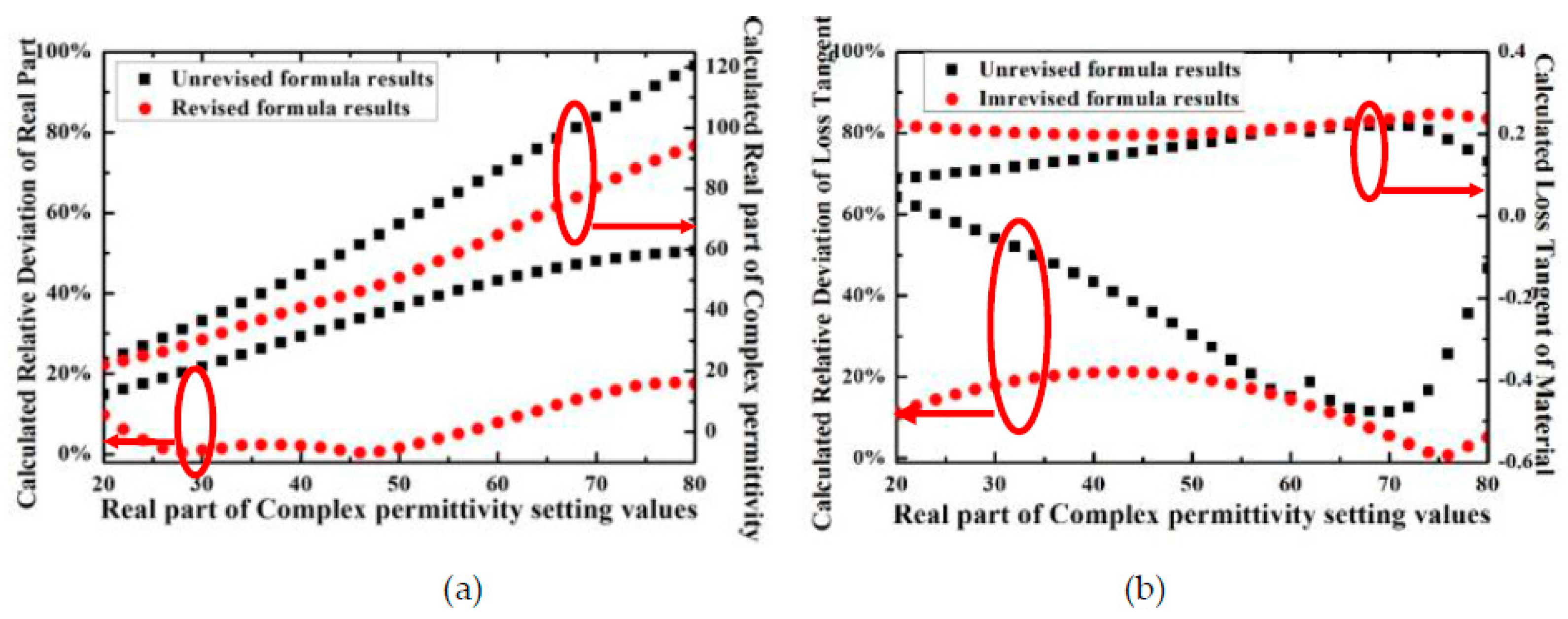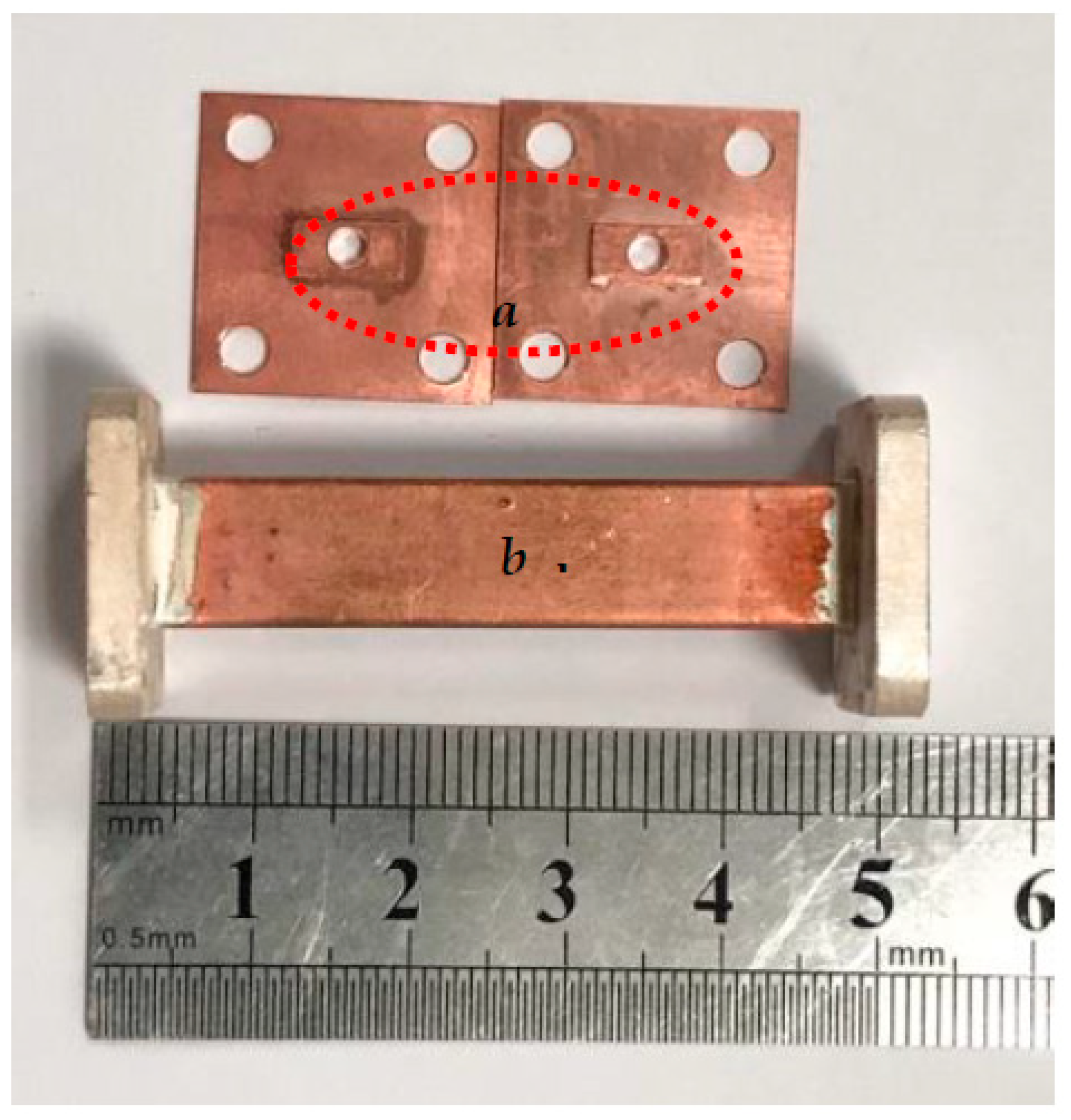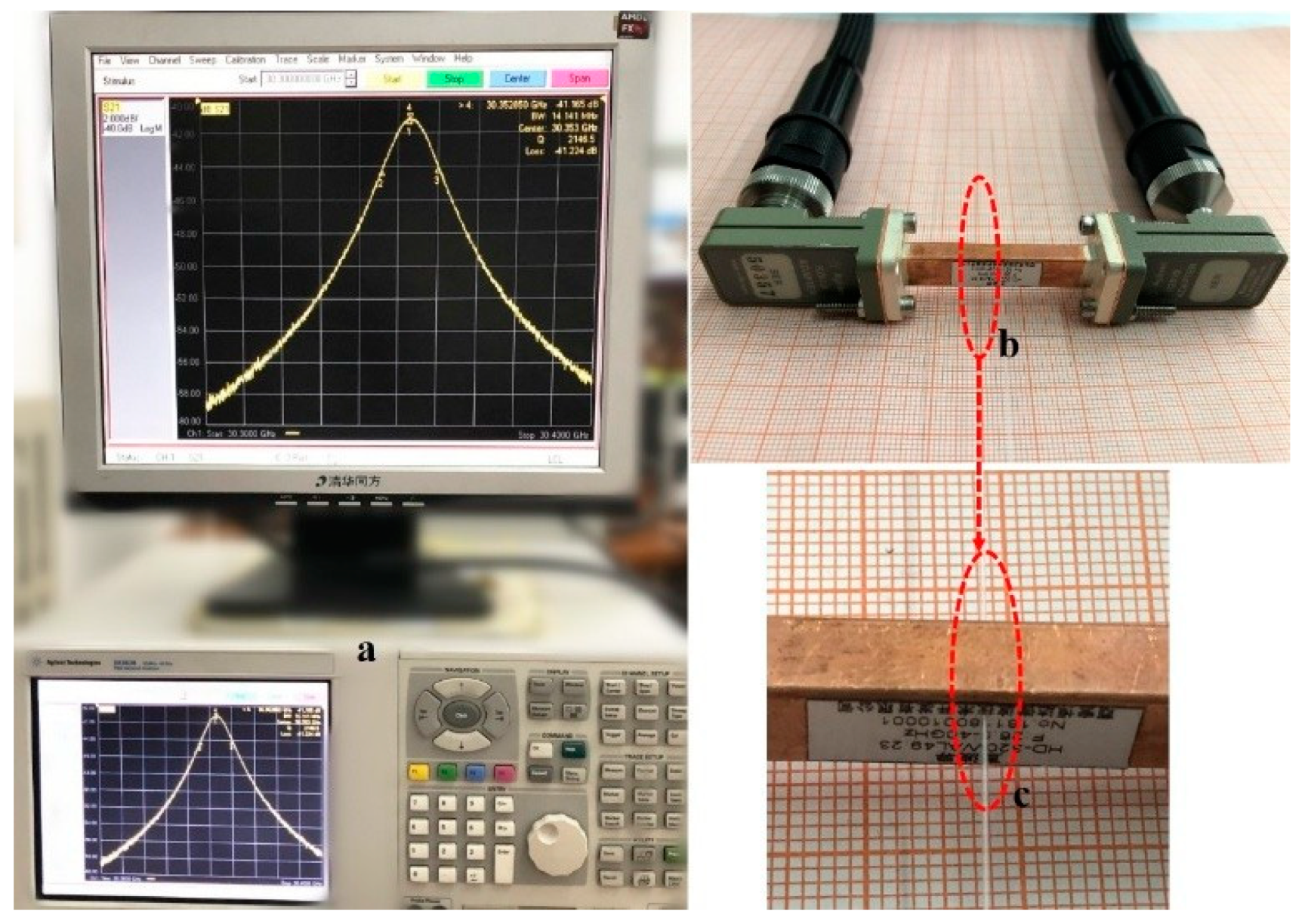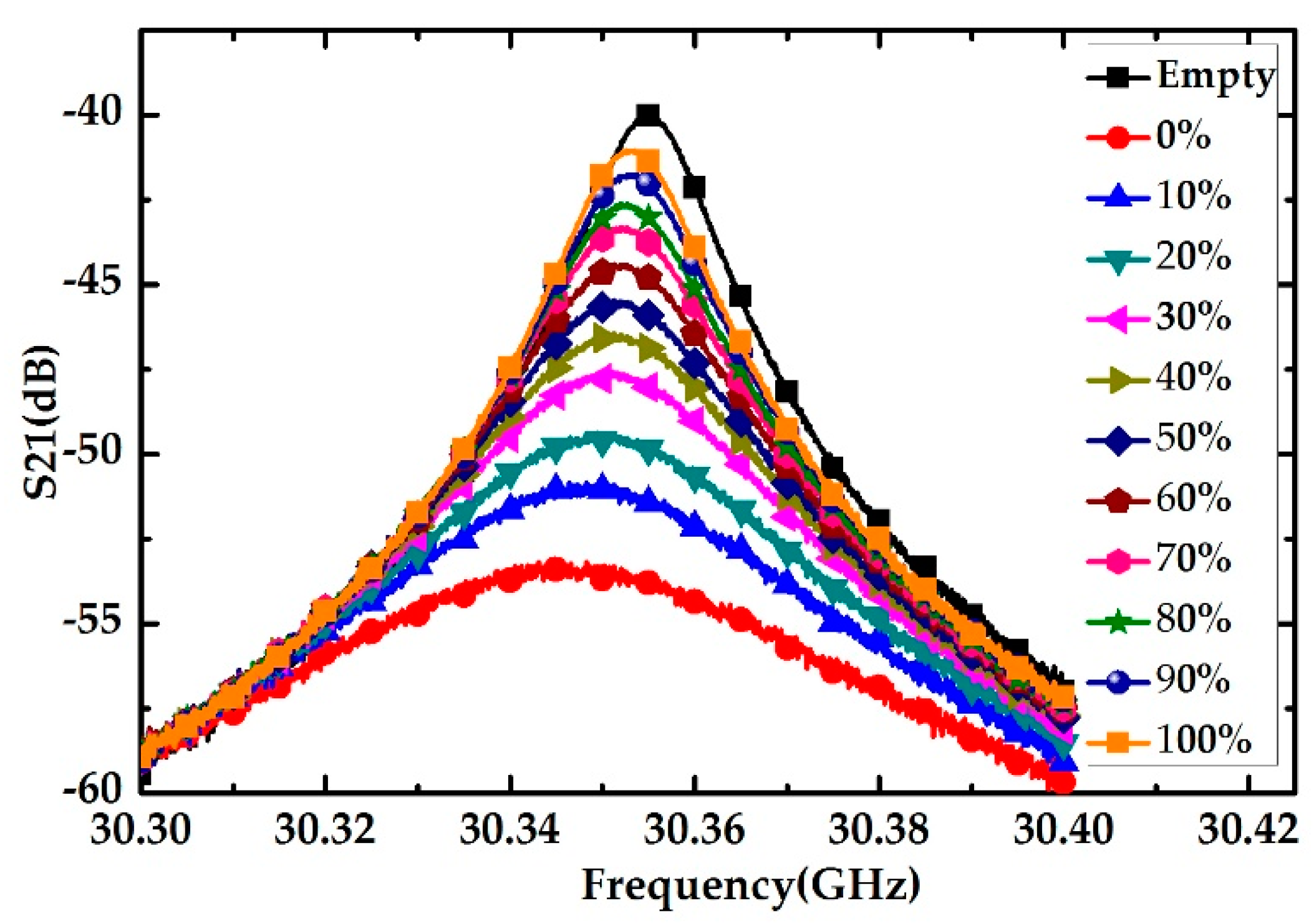Complex Permittivity Measurement of High-Loss Biological Material with Improved Cavity Perturbation Method in the Range of 26.5–40 GHz
Abstract
:1. Introduction
2. Theory of Improved Cavity Perturbation Technology
3. Experimental Verification
4. Measurement Results of Two Types of Cancer Cells
- (1)
- An empty capillary tube was inserted at the position of a/16 close to the wall of the cavity, where a is the wide side of the WR28 rectangular waveguide. Unloaded measurements of resonant frequency (f0) and quality factor (Q0) were obtained and measured, the inner diameter of the capillary is small, and the entire measurement time is very short. Therefore, it can be assumed that the liquid sample is not volatilized, and the volume does not change during the entire measurement process.
- (2)
- The standard sample liquid anhydrous alcohol is filled in the capillary tube with an inner diameter of 0.12 mm and then sealed. The resonance frequency (fs) and loaded quality factor (Qs) are measured and recorded.
- (3)
- Suspended cancer cells with the volume of 0.16 μL were filled in the capillary tube and then inserted at the same location for measurements. The resonance frequency (fmix) and loaded quality factor (Qmix) are measured and recorded.
- (4)
- The same process is used to measure the medium(solvent) without cancer cells. The resonance frequency (fm) and loaded quality factor (Qm) are measured and recorded.
- (5)
- Measurements were performed on two different cancer cell samples. The full test duration of each sample was less than 15 s to avoid heating effects.
- (6)
- With the utilization of Hanai’s mixed formula, the complex permittivity of a single cell can be calculated from the measurement data of the mixture cell/medium and medium solution.
5. Conclusions
Author Contributions
Funding
Acknowledgments
Conflicts of Interest
References
- Kraszewski, A.W.; Trabelsi, S.; Nelson, S.O. Moisture content determination in grain by measuring microwave parameters. Meas. Sci. Technol. 1997, 8, 857–863. [Google Scholar] [CrossRef]
- Chen, L.-F.; Ong, C.; Neo, C.; Varadan, V.; Varadan, V.K. Microwave Electronics: Measurement and Materials Characterization; John Wiley & Sons, Inc.: Hoboken, NJ, USA, 2004. [Google Scholar]
- Nelson, S.; Trabelsi, S. A century of grain and seed moisture measurement by sensing electrical properties. Trans. ASABE 2012, 55, 629–636. [Google Scholar] [CrossRef]
- Duhamel, F.; Huynen, I.; Vander Vorst, A. Measurements of complex permittivity of biological and organic liquids up to 110 GHz. In Proceedings of the 1997 IEEE MTT-S International Microwave Symposium Digest, Denver, CO, USA, 8–13 June 1997; pp. 107–110. [Google Scholar]
- Michel, E.; Hernandez, D.; Lee, S.Y. Electrical conductivity and permittivity maps of brain tissues derived from water content based on T1-weighted acquisition. Magn. Reson. Med. 2017, 77, 1094–1103. [Google Scholar] [CrossRef] [PubMed]
- Peyman, A.; Kos, B.; Djokic, M.; Trotovsek, B.; Limbaeck-Stokin, C.; Sersa, G.; Miklavcic, D. Variation in dielectric properties due to pathological changes in human liver. Bioelectromagnetics 2015, 36, 603–612. [Google Scholar] [CrossRef] [PubMed]
- Semenov, S.; Huynh, T.; Williams, T.; Nicholson, B.; Vasilenko, A. Dielectric properties of brain tissue at 1 GHz in acute ischemic stroke: Experimental study on swine. Bioelectromagnetics 2017, 38, 158–163. [Google Scholar] [CrossRef]
- Minerick, A.R.; Zhou, R.; Takhistov, P.; Chang, H.C. Manipulation and characterization of red blood cells with alternating current fields in microdevices. Electrophoresis 2003, 24, 3703–3717. [Google Scholar] [CrossRef]
- Bharati, S.; Rishi, P.; Tripathi, S.K.; Koul, A. Changes in the electrical properties at an early stage of mouse liver carcinogenesis. Bioelectromagnetics 2013, 34, 429–436. [Google Scholar] [CrossRef]
- Bouazizi, A.; Zaibi, G.; Samet, M.; Kachouri, A. Parametric study on the dielectric properties of biological tissues. In Proceedings of the 2015 16th International Conference on Sciences and Techniques of Automatic Control and Computer Engineering (STA), Monastir, Tunisia, 21–23 December 2015; pp. 54–57. [Google Scholar]
- Kwon, H.; Guasch, M.; Nagy, J.A.; Rutkove, S.B.; Sanchez, B. New electrical impedance methods for the in situ measurement of the complex permittivity of anisotropic skeletal muscle using multipolar needles. Sci. Rep. 2019, 9, 3145. [Google Scholar] [CrossRef] [Green Version]
- Yang, L.; Zhang, G.; Song, J.; Dai, M.; Xu, C.; Dong, X.; Fu, F. Ex-Vivo Characterization of Bioimpedance Spectroscopy of Normal, Ischemic and Hemorrhagic Rabbit Brain Tissue at Frequencies from 10 Hz to 1 MHz. Sensors 2016, 16, 1942. [Google Scholar] [CrossRef] [Green Version]
- Chen, T.; Artis, F.; Dubuc, D.; Fournie, J.; Poupot, M.; Grenier, K. Microwave biosensor dedicated to the dielectric spectroscopy of a single alive biological cell in its culture medium. In Proceedings of the 2013 IEEE MTT-S International Microwave Symposium Digest (MTT), Seattle, WA, USA, 2–7 June 2013; pp. 1–4. [Google Scholar]
- Chen, T.; Dubuc, D.; Poupot, M.; Fournié, J.-J.; Grenier, K. Broadband discrimination of living and dead lymphoma cells with a microwave interdigitated capacitor. In Proceedings of the 2013 IEEE Topical Conference on Biomedical Wireless Technologies, Networks, and Sensing Systems, Austin, TX, USA, 20–23 January 2013; pp. 64–66. [Google Scholar]
- Ko, J.; Carpenter, E.; Issadore, D. Detection and isolation of circulating exosomes and microvesicles for cancer monitoring and diagnostics using micro-/nano-based devices. Analyst 2016, 141, 450–460. [Google Scholar] [CrossRef] [Green Version]
- Morgan, H.; Sun, T.; Holmes, D.; Gawad, S.; Green, N.G. Single cell dielectric spectroscopy. J. Phys. D Appl. Phys. 2007, 40, 61–70. [Google Scholar] [CrossRef]
- Zhou, Y.; Basu, S.; Laue, E.; Seshia, A.A. Single cell studies of mouse embryonic stem cell (mESC) differentiation by electrical impedance measurements in a microfluidic device. Biosens Bioelectron. 2016, 81, 249–258. [Google Scholar] [CrossRef] [PubMed] [Green Version]
- Alekseev, S.I.; Ziskin, M.C. Human skin permittivity determined by millimeter wave reflection measurements. Bioelectromagnetics 2007, 28, 331–339. [Google Scholar] [CrossRef] [PubMed]
- Seo, S.; Stintzing, T.; Block, I.; Pavlidis, D.; Rieke, M.; Layer, P.G. High frequency wideband permittivity measurements of biological substances using coplanar waveguides and application to cell suspensions. In Proceedings of the 2008 IEEE MTT-S International Microwave Symposium Digest, Atlanta, GA, USA, 15–20 June 2008; pp. 915–918. [Google Scholar]
- Sun, T.; Morgan, H. Single-cell microfluidic impedance cytometry: A review. Microfluid. Nanofluidics 2010, 8, 423–443. [Google Scholar] [CrossRef]
- Chen, W.; Dubuc, D.; Grenier, K. Microwave dielectric spectroscopy of a single biological cell with improved sensitivity up to 40 GHz. In Proceedings of the 2015 IEEE MTT-S International Microwave Symposium, Phoenix, AZ, USA, 17–22 May 2015; pp. 1–3. [Google Scholar]
- Jylhä, L. Modeling of Electrical Properties of Composites. 2008. Available online: https://aaltodoc.aalto.fi/handle/123456789/4583 (accessed on 8 February 2020).
- Stiharu, I.; Alazzam, A.; Nerguizian, V.; Roman, D. Single living cell manipulation and identification using microsystems technologies. Microsyst. Nanoeng. 2015, 1, 1–8. [Google Scholar] [CrossRef] [Green Version]
- Waldron, R.A. Perturbation theory of resonant cavities. Proc. IEE-Part C Monogr. 1960, 107, 272–274. [Google Scholar] [CrossRef]
- Buravov, L.; Shchegolev, I. Method of conductivitry measurement on small crystals at frequency 10ˆ10 HZ. Exp. Tech 1971, 14, 528–531. [Google Scholar]
- Klein, O.; Donovan, S.; Dressel, M.; Grüner, G. Microwave cavity perturbation technique: Part I: Principles. Int. J. Infrared Millim. Waves 1993, 14, 2423–2457. [Google Scholar] [CrossRef]
- Donovan, S.; Klein, O.; Dressel, M.; Holczer, K.; Grüner, G. Microwave cavity perturbation technique: Part II: Experimental scheme. Int. J. Infrared Millim. Waves 1993, 14, 2459–2487. [Google Scholar] [CrossRef]
- Dressel, M.; Klein, O.; Donovan, S.; Grüner, G. Microwave cavity perturbation technique: Part III: Applications. Int. J. Infrared Millim. Waves 1993, 14, 2489–2517. [Google Scholar] [CrossRef]
- Chang, K.; Wiley, J. Encyclopedia of RF and Microwave Engineering; Wiley-Interscience: Hoboken, NJ, USA, 2005. [Google Scholar]
- Grimnes, S.; Martinsen, O. Bioimpedance and Bioelectricity Basics; Academic Press: Cambridge, MA, USA, 2000. [Google Scholar]
- Kraszewski, A.W.; Nelson, S.O. Observations on resonant cavity perturbation by dielectric objects. IEEE Trans. Microw. Theory Tech. 1992, 40, 151–155. [Google Scholar] [CrossRef]
- Lakhtakia, A.; Varadan, V.K.; Varadan, V.V. Time-Harmonic Electromagnetic Fields in Chiral Media; Springer: Berlin/Heidelberg, Germany, 1989. [Google Scholar]
- Akyel, C.; Bosisio, R.G. New developments on automated-active circuits for permittivity measurements at microwave frequencies. IEEE Trans. Instrum. Meas. 1989, 38, 496–504. [Google Scholar] [CrossRef]
- Lin, M.; Afsar, M.N. A new cavity perturbation technique for accurate measurement of dielectric parameters. In Proceedings of the 2006 IEEE MTT-S International Microwave Symposium Digest, San Francisco, CA, USA, 11–16 June 2006; pp. 1630–1633. [Google Scholar]
- Gresits, I.; Thuróczy, G.; Sági, O.; Homolya, I.; Bagaméry, G.; Gajári, D.; Babos, M.; Major, P.; Márkus, B.; Simon, F. A highly accurate determination of absorbed power during magnetic hyperthermia. J. Phys. D Appl. Phys. 2019, 52, 375–401. [Google Scholar] [CrossRef] [Green Version]
- Gyüre, B.; Márkus, B.; Bernáth, B.; Murányi, F.; Simon, F. A time domain based method for the accurate measurement of Q-factor and resonance frequency of microwave resonators. J. Phys. D Appl. Phys. 2015, 86, 094702. [Google Scholar] [CrossRef] [PubMed] [Green Version]
- Gyüre-Garami, B.; Sági, O.; Márkus, B.; Simon, F. A highly accurate measurement of resonator Q-factor and resonance frequency. Rev. Sci. Instrum. 2018, 89, 113903. [Google Scholar] [CrossRef] [Green Version]
- Taylor, L. Dielectric properties of mixtures. IEEE Trans. Antennas Propag. 1965, 13, 943–947. [Google Scholar] [CrossRef]
- Hanai, T.; Asami, K.; Koizumi, N. Dielectric Theory of Concentrated Suspensions of Shell-Spheres in Particular Reference to the Analysis of Biologica Cell Suspensions. 1979. Available online: https://repository.kulib.kyoto-u.ac.jp/dspace/bitstream/2433/76842/1/chd057_4_297.pdf (accessed on 20 December 2019).
- Meriakri, V.; Chigrai, E. Determination of alcohol and sugar content in water solutions by means of microwave. In Proceedings of the Fifth International Kharkov Symposium on Physics and Engineering of Microwaves, Millimeter, and Submillimeter Waves, Kharkov, Ukraine, 21–26 June 2004; pp. 821–823. [Google Scholar]







| Cavity Mode | TE107 |
|---|---|
| Length of cavity | 48.60 mm |
| Resonant frequency | 30.13 GHz |
| Diameter of the coupling hole | 2.40 mm |
| The volume of cavity | 1.23 × 103 mm3 |
| The volume of sample | 0.16 mm3 |
| Material | Frequency Shift (MHz) | Q-Factor |
|---|---|---|
| Empty | -- | 2463.8 |
| 0% (Deionized water) | 9.833 | 569.46 |
| 10% | 6.458 | 720.15 |
| 20% | 5.252 | 838.20 |
| 30% | 4.777 | 1014.6 |
| 40% | 4.431 | 1151.0 |
| 50% | 3.475 | 1325.7 |
| 60% | 3.191 | 1447.4 |
| 70% | 2.837 | 1641.1 |
| 80% | 2.750 | 1842.5 |
| 90% | 2.067 | 2006.8 |
| 100% (alcohol) | 2.110 | 2174.4 |
| Cavity Mode | TE105 | TE107 | TE109 |
|---|---|---|---|
| Length of cavity | 48.7 mm | 48.7 mm | 48.7 mm |
| Resonant frequency | 26.58 GHz | 30.35 GHz | 35.11 GHz |
| Diameter of the coupling hole | 2.6 mm | 2.4 mm | 3.0 mm |
| Frequency | Breast-MDA231 | Uveal Melanoma | ||
|---|---|---|---|---|
| 26.6 GHz | 13.8 ± 0.8 | 30.3 ± 0.8 | 14.6 ± 1.0 | 34.3 ± 1.1 |
| 30.3 GHz | 12.6 ± 1.2 | 28.2 ± 1.3 | 11.2 ± 2.4 | 31.6 ± 1.4 |
| 35.1 GHz | 10.3 ± 1.1 | 25.7 ± 1.0 | 8.2 ± 0.1 | 27.5 ± 1.8 |
© 2020 by the authors. Licensee MDPI, Basel, Switzerland. This article is an open access article distributed under the terms and conditions of the Creative Commons Attribution (CC BY) license (http://creativecommons.org/licenses/by/4.0/).
Share and Cite
Ma, J.; Wu, Z.; Xia, Q.; Wang, S.; Tang, J.; Wang, K.; Guo, L.; Jiang, H.; Zeng, B.; Gong, Y. Complex Permittivity Measurement of High-Loss Biological Material with Improved Cavity Perturbation Method in the Range of 26.5–40 GHz. Electronics 2020, 9, 1200. https://doi.org/10.3390/electronics9081200
Ma J, Wu Z, Xia Q, Wang S, Tang J, Wang K, Guo L, Jiang H, Zeng B, Gong Y. Complex Permittivity Measurement of High-Loss Biological Material with Improved Cavity Perturbation Method in the Range of 26.5–40 GHz. Electronics. 2020; 9(8):1200. https://doi.org/10.3390/electronics9081200
Chicago/Turabian StyleMa, Jialu, Zhe Wu, Qiong Xia, Shaomeng Wang, Jingchao Tang, Kaicheng Wang, Lianghao Guo, Haibo Jiang, Baoqing Zeng, and Yubin Gong. 2020. "Complex Permittivity Measurement of High-Loss Biological Material with Improved Cavity Perturbation Method in the Range of 26.5–40 GHz" Electronics 9, no. 8: 1200. https://doi.org/10.3390/electronics9081200
APA StyleMa, J., Wu, Z., Xia, Q., Wang, S., Tang, J., Wang, K., Guo, L., Jiang, H., Zeng, B., & Gong, Y. (2020). Complex Permittivity Measurement of High-Loss Biological Material with Improved Cavity Perturbation Method in the Range of 26.5–40 GHz. Electronics, 9(8), 1200. https://doi.org/10.3390/electronics9081200





